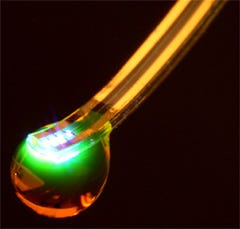This Is How You Wirelessly Provide Brain Control
July 20, 2015
U.S. scientists have developed a new wireless brain probe made of soft materials that can simultaneously deliver drugs and lights to the brain to help control neurons.
|
(Image courtesy of of Jeong lab, University of Colorado Boulder) |
Kristopher Sturgis
A remote-controlled, next-gen tissue implant could enable neuroscientists to inject drugs and shine lights on neurons inside the brain to elicit controlled reactions.
The new device--created by researchers at the Washington University School of Medicine in St. Louis and the University of Illinois, Urbana-Champaign--is made from soft materials that are roughly a tenth the diameter of a human hair and can simultaneously deliver drugs and lights wirelessly. This is the first time such a device has been created, according to the a news release from the NIH's National Institute of Neurological Disorders and Stroke, which partially funded the research.
Such a device has been needed because researchers have only been able to study the circuits inside the brain with the help of bulky metal tubes, and the insertion of fiber optic cables. It is a process that proved not only extremely invasive, but also fairly difficult and time consuming. With the use of this new wireless probe, the research group looked to gain access to a variety of circuits that control several different common disorders in the brain including stress, depression, addiction, and pain.
Through the power of nano-manufacturing strategies, the group was able to produce an implant that allows them to penetrate deep inside the brain with minimal damage or difficulty. The device itself is only 80 micrometers thick and 500 micrometers wide, making it significantly thinner than the metal tubes typically used to inject drugs into the brain.
Researchers tested the device's drug delivery abilities by surgically implanting the optofluidic device into the brains of mice. In subsequent experiments, the group found that they could map circuits with precision by using the implant to inject viruses that can label cells with genetic dyes. In other experiments, researchers actually used the device to make mice walk in circles by injecting a drug--one that mimics morphine--into a region of the brain that controls motivation and addiction.
The probe technology is the latest in a string of brain sensor technologies that look to enhance brain function and ability wirelessly. Earlier this year researchers from Brown University developed a wireless transmitter that could provide paralyzed patients with the ability to control electronics with their thoughts. A development came along just a few months after the same university published details of a wireless brain sensor that enabled scientists to monitor brain brain activity without tethering patients to a machine through cumbersome cables and wires.
All of these developments are about minimally invasive technologies to open up access to the brain in new and exciting ways. In the case of the new wireless brain probe, researchers believes it could be a tool that helps provide them with the necessary means to map out brain circuitry activity both efficiently and comprehensively.
Refresh your medical device industry knowledge at MEDevice San Diego, September 1-2, 2015. |
Kristopher Sturgis is a contributor to Qmed and MPMN.
Like what you're reading? Subscribe to our daily e-newsletter.
About the Author(s)
You May Also Like



